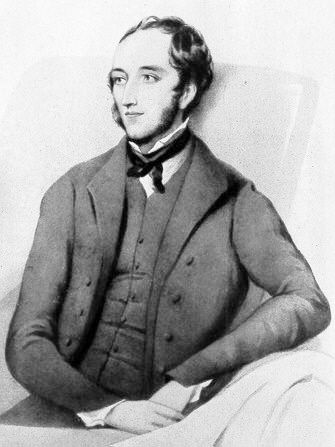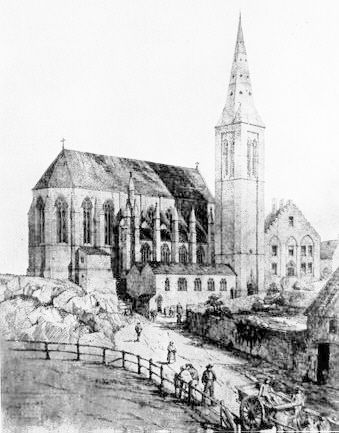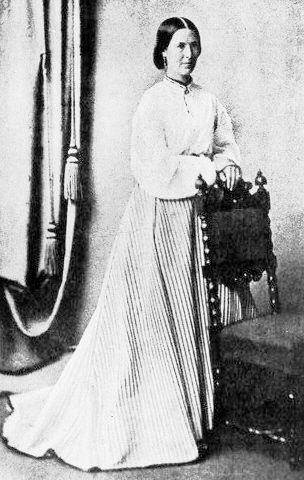George Hay Forbes (1821-75)
Episcopal priest, distinguished scholar and publisher.

George Hay Forbes
George Hay Forbes' life can only be described as one of amazing achievement in the face of very considerable adversity. Born to a well-to-do and well-connected Edinburgh family, he had the misfortune to contract a crippling disease, perhaps polio, at an early age and lost the use of his legs. Although his family spent large sums in attempts to find a cure, he was to be dependent on crutches and other aids for the rest of his life.
He was ordained in May 1848, and a few months later was despatched to Burntisland by the Bishop of St Andrews. His mission was to revive the Episcopal Church in Burntisland.
He stayed initially at 12 Craigholm Crescent (now part of Kinghorn Road) and arranged his first services in the Town Hall. But the local folk did not immediately take to this intense, scholarly and seriously disabled young man. The story is told of how, one frosty day, he fell in the High Street and had to struggle up by himself with no assistance from the onlookers.
No doubt this made him even more determined to succeed. He devised a plan for an extremely ambitious church complex in East Leven Street, comprising a home and working premises for himself, a school, and a church so grand that it would have dwarfed many a cathedral. The artist's impression gives an idea of the scale of his plans, and shows the Parsonage and the school (now the Pipe Band Hall).
The home and working premises, the Parsonage, were built first. The building was designed by R.C. Carpenter, the London architect. It was described by the Victorian Society many years later as one of his finest, and "one of the most important buildings of the mid Victorian period".
It was a substantial home for one family, but into it had to be fitted the living quarters, the minister's study and library, and - in the basement - a substantial printing press and space for the seven workers whom he was to employ. He moved into the new building in 1854, despite the absence of curtains, wallpaper, carpets and - in some rooms - plaster on the walls and ceiling. It is said that he later fixed a rope to the rafters of the building, and used it to achieve a quick descent to the lower floors.

How Forbe's Church would have looked like
The school (now the Pipe Band Hall) was also built in 1854. It doubled as a temporary venue for church services on Sundays, with the harmonium being carried in from the Parsonage before each morning service.
Keen to press on with his grand design, Forbes made a start on the new church in 1855. Progress was slow but, if he ran out of money, he would resort to cutting stones himself. Sadly, despite his efforts, only the baptistry of the church was ever completed.
So why do we remember the man today? He was a pastor of note, but what else? First and foremost, he was a brilliant scholar; some would say a genius. Many of his successes seem rather obscure in this day and age, but we must remember that, in the 19th century, there was lively religious debate and a hunger all over the world for published material to fuel it.
Forbes contributed a great deal in these spheres - ideas, translations, and published works. He published under the name of The Pitsligo Press, and from the basement of the Parsonage emanated works in many of the several dozen languages which he had mastered. Despite his disability, he visited a number of European countries to carry out original research in libraries and archives.
He was also keen to see a distinctly Scottish approach to the structure of Episcopal Church services. He produced a Scottish Prayer Book, and in this he incurred the wrath of his superiors who were loathe to countenance any significant divergence from the position in England. Forbes went to court in an attempt to have his prayer book accepted, but lost. After his time, however, his ideas on these questions were accepted, and the Scottish church now comfortably adopts an independent stance.
His marriage in Burntisland in 1853 to Eleanor Wemyss (pictured left), daughter of an army officer, brought great happiness to both of them. Although Eleanor had been brought up to anticipate the life of a genteel lady, she soon adapted to the reality of the Parsonage, and before long was able to set type and read proofs as well as anyone.
The couple had no children of their own, but adopted a French girl, Marie. Marie did not have a life of idleness, either, and in due course took on secretarial duties and the training of the church choir. Her presence brought a new cheerfulness to what must at times have seemed a rather serious establishment. Eventually Marie was to marry a French aristocrat, the Count de l'Espinasse. Even after Forbes' death, the Countess did not forget her home town - for example, in 1893, she paid a visit to the Episcopal School at Mount Pleasant.

Eleanor Wemyss Forbes
In 1869, Forbes decided to try his hand at local politics and stood in the Town Council elections. Although the attendance at his church services rarely exceeded 30, he had gained widespread respect in the town and he came top of the poll. He served as provost from 1869 to 1870, and immersed himself in negotiations with the railway company on the question of the creation of the West Dock. He was mistrustful of the railway company, but, getting little support from his fellow councillors, he resigned. His view eventually proved to have been correct.
He was also one of the early leaders of the Co-operative movement.
On a visit to France in 1872, he fell and injured himself, and from then on his health deteriorated. He died on the 7th of November, 1875, and was interred in Warriston Cemetery, Edinburgh. It is said that, on the day of the funeral, most of the population of Burntisland followed the coffin to the harbour to say a last farewell.
Forbes' publishing work at the Parsonage was carried on by Canon Walter Bell for a number of years. The building was then sold to the railway company for accommodation for its employees; and was eventually bought by the Town Council. The school moved to the old Burgh School building at Mount Pleasant around 1876. Forbes' school building became a drill hall, and was bought by Burntisland & District Pipe Band in the early 1950s. Sadly, the small part of his great church which had been completed at the time of his death was dismantled - but the materials found a new role in the construction of St Margaret's, Leven.

